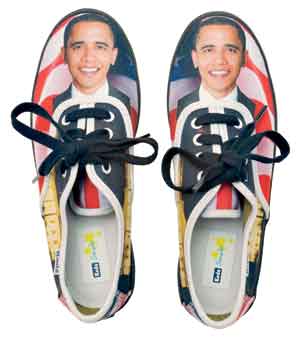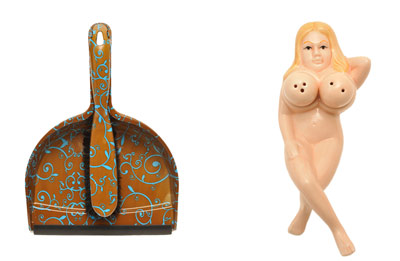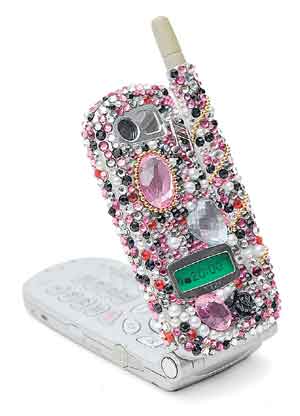悪趣味デザイン展覧会 [デザイン/建築]
「『趣味が良い』がどういうことかを理解する前に、私たちはまず悪趣味を駆逐しなければならない」。Gustav Edmund Pazaurek。


1865年にプラハで生まれた美術・博物学者のGustav Edmund Pazaurekは、一般市民が「良いモノ」とは何かを知り、駆逐すべき悪趣味を示すため、1909年に南ドイツ・シュツットガルトの州立工芸博物館内にAbteilung der Geschmacksverirrungen(Cabinet of Bad Taste)をつくり、自身が設けたバッドテイスト分類カテゴリーに照らし合わせた悪趣味製品を実際に展示して見せた。それはドイツ工作連盟の啓蒙活動の一環でもあった。選択基準は、誤った素材、誤ったデザイン、誤った装飾などのカテゴリーに分けられていて、それぞれにサブカテゴリーの基準がある。(記事末参照、英語です)。
かつてヨーロッパではドイツ製品は粗悪品の代名詞だった。ドイツ工作連盟設立はドイツ製品の品質向上の目的も大きかった。製造者教育はもちろんだが、ドイツ工作連盟は実際にモノを使う市民たちの審美眼を鍛えるためにさまざまな啓蒙活動を行っていたのだ。使い手がモノに対して厳しい目を持てないと、つくり手も成長しないからだ。子どもたちの教育のために「良い製品とは何か」を教える教材キットもつくり、連盟の担当者はそれを携えてドイツ国内の学校を巡り、今風に言えばグッドデザインとは何かを子どもたちに教えていた。
この教材は「Werkbundarchiv – Museum der Dinge」に常設展示されている。
ベルリンにある「Werkbundarchiv – Museum der Dinge」では、今年の1月11日までPazaurekのCabinet of Bad Tasteを現代に再現する「EVIL THINGS. AN ENCYCLOPEDIA OF BAD TASTE(悪趣味製品大全)」を開催していた。まず、シュツットガルトの州立博物館にあるPazaurek選バッドテイスト収蔵品を借りて展示し、さらにベルリン市民にPazaurekのバッドテイスト分類カテゴリーに適う「酷い製品」を募って、各家庭にあるバッドテイストな品を集め、それを一覧展示することで「悪趣味製品大全」は構成されていた。この展覧会をベルリン在住の阿部雅世さんに教えていただき、昨年秋にベルリンを訪れた際に案内してもらった。この博物館はユーゲントシュティールの建物の中にある。夕暮れの階段を上り博物館へ。

展示品はこんな感じ。超面白かった。市民が応募したバッドテイスト製品の中にはフィリップ・スタルクのデザインが何点かあった。フツーの人に選ばれるなんて、スタルク先生にはまた新しい勲章が加わったね。




こういう展覧会、展示品を製造販売している企業のことを考えると日本では難しいんでしょうね。この博物館では常設展示で日用品のパッケージや子どもの玩具を旧東西ドイツで比較展示していたり、名品から名もない品まで、フツーの家庭で使われていた製品を時代別やカテゴリー別にざっくりと展示していて、何時間見ていても飽きないと思う。これがドイツのアーカイブ文化なんだな。一点一点にキャプションはなくて、カテゴリーごとに大まかな解説がある。
以前、ノイハウゼン市役所内の美術館で見た「legal / illegal, Art beyond Law」という現代美術の展覧会を思い出した。
Werkbundarchiv – Museum der Dinge
Oranienstraße 25
D-10999 Berlin
BAD TASTE, Systematized by Gustav E. Pazaurek
I. Material Mistakes
Bad and Spoiled Materials
Inferior materials such as knotty wood, poor alloys, or toxic substances; products that are poorly or cheaply processed or manipulated to conceal flaws; distorted moulds, heat checks, spotted or bubbled glaze, colour flaws, glazing flaws, reams.
Bizarre Materials
Objects of human bone, skin, fingernails or hair; rhinoceros horns, ostrich eggs, shed antlers, animal teeth, vertebrae, feathers, fish scales; lizards, lobster claws, butterfly wings, beetle wings, live fireflies, egg membrane, cherry stones, spices, hazelnuts, straw, pine cones, mosses, tree fungus, cork, coloured sand, vegetables, sugar, butter, ice, bread, etc.
Material Obsessions
Painstaking hobby handicrafts with inferior or waste materials which, seen from a distance, look like craft products, such as objects made of postage stamps, matches, cigar rings, patchwork, broken glass, sardine tins, corks, used paper, wax, etc.
Violations of Materials
Often very cleverly worked objects which overtax or completely disregard the properties of the chosen material; and objects made of perfectly good materials which are poorly or not at all suited to the purpose at hand.
Ostentatious Materials
Objects made of materials that are too good or too costly; objects that “flaunt their wealth”. The craftsmanship is usually less artful than the valuable material deserves.
Material Infringement
The substance of one object is used in the spirit of another. These objects are based on clever little ideas; there is no intent to deceive by imitating another material. Rather, the objects are crafted in the style that is appropriate to a foreign material, with its typical forms and marks of handiwork.
Material Decoys
Material decoys are playful attempts to imitate other materials without disguising the actual material substance of the object. Although the purpose is to create an illusion, the intent is not to deceive, but to make a “more or less clever, but usually shallow material pun.”
Material Surrogates
Material surrogates are inferior materials masquerading as more valuable ones. They imitate a costly material as closely as possible, with the intent to deceive and defraud the observer.
Reverse Surrogates
Unlike normal surrogates, reverse surrogates are imitations of an inferior material in a superior one. The substitute material is more expensive than the original.
II. Design Mistakes
Relief Transpositions
Translation of flat forms into relief (or vice versa), such as three-dimensional representations of popular paintings, or sculptures of individual figures from such paintings.
Unbalanced Weight
Objects made too heavy or too light; inconvenient distribution of weight; centre of gravity too high; base too small or extremely large.
Unsuitable or Tricky Objects
Vessels that tip easily or cannot be cleaned; handles that can’t be gripped; objects with sharp edges; also objects with overly fantastic or rich decoration at the expense of practical utility.
Cross-Purposes
Combination objects that ostensibly serve two or more purposes, but are not optimally suitable for any of them.
Functional Lies
Objects or parts which look deceptively useless or delicate, make false representations, or are superfluous, such as architectural ornamentation or decorative buttons.
Design Decoys and Artistic Pranks
Useful objects in forms that bear no relation to their purpose. The functional form is replaced with “far-fetched fantasy designs”.
Technical Surrogates
An elaborate craftsman’s technique is imitated in the original material by machine; a difficult method or technique is merely feigned.
Patent Humour
Useless, frivolous inventions; bad designs that concentrate attention on unimportant secondary purposes at the expense of the principal function.
Cheap Originality
Crude forgeries, unimaginative imitations of established designs and forms, plagiarism.
III. Decorative Mistakes
Odd Proportions
Obtrusive, abnormal shapes and proportions that detract from the clarity and familiarity of a traditional, functional form.
Manic Ornamentation, Wasteful Decoration
Excessive inundation with ornament and extreme decoration, which can deteriorate into the “infectious and therefore very dangerous illness of ornamentational rage”.
Art as Atonement
Addition of decorative elements to hide material flaws or for lack of another way to “distract attention from a botched functional and artistic design”.
Misplaced or Misoriented Ornamentation
Unskilled use of decorative elements in regard to their relationship to the artistic form or to other decorative elements, or in regard to the intrinsic logic of the ornamentation, such as the direction of growth in botanical motifs.
Decorative Brutality
“When one of two decorative schemes not only disregards the other, but destroys it to usurp its place, that is brutality.”
Decorative Invasions
These objects are formed in a way that is typical for the material, but their surface imitates a different material, such as marbling on wood or gilding on porcelain or glass.
Recipe and Chance
Ornamentation created by the use of time-honoured recipes, especially those that make use of chance, such as ink blots, poured glaze, pictures drawn while in a trance, or pattern designers’ catalogues.
Original Decorative Ideas
Decorative designs that are contrived, affected or excessively “original”.
“Not all originality is praiseworthy. Some kinds of originality can only be called oddity [...] Such things may indeed be original, but that does not make them beautiful.”
Unfitting Decorative Motifs
Decoration that violates taste or the function of the object; unappetizing decorative motifs; mockery and misuse of national emblems for purely decorative purposes.
Anachronistic or Exotic Decoration
Motifs and ornaments copied from past stylistic currents and foreign cultures.
Exaggerated Finishing
Excessive use of a surface effect such as gilding, mother-of-pearl, iridescence, lustre, or fluorescence.
Primitive Decoration
An unimaginative, simple pattern used to adorn everything, such as a checkerboard or cube pattern.
Naive Decoration and Familiarity
Supposed folk art; inappropriately crude craftsmanship.
IV. Kitsch
Cheap mass rubbish with no attention given to the choice of materials, forms and decoration. The most common sub-categories are:
Jingoistic Kitsch (especially World War horrors)
Topical Kitsch
Travel Souvenir Kitsch
Folklore and Sportsmen’s Kitsch
Devotional Kitsch
Commercial Kitsch
“The absolute antithesis of artistically inspired work of quality is tasteless mass rubbish, or kitsch: it disregards all the demands of ethics, logic and aesthetics; it is indifferent to all crimes and offences against material, technique, and functional or artistic form; it knows only one commandment: the object must be cheap and yet still attempt to create at least some impression of a higher value.” After Gustav E. Pazaurek, Guter und schlechter Geschmack im Kunstgewerbe, Berlin 1912
V. Contemporary Mistakes
Glorification of Violence
Brutalizing objects; objects that encourage or trivialize violence and offences against humans and animals.
Harmful Toys
Objects that encourage physically or morally harmful activities.
Child Labour
Objects produced by working children.
Waste of Resources
Mass-produced, single-use articles; disproportionate, non-sustainable use of limited raw materials.
Pollution
Insufficient regard for the consequences of the harmful substances involved in production.
Cadaver Chic
Objects that dramatize or demonstrate Man’s absolute power over the animal kingdom, such as trophies and travel souvenirs.
Crimes against Endangered Species
Objects made of endangered animal or plant materials.
Sexist Design
Discriminatory use of over-stylized and stereotyped gender characteristics in design.
Racist Design
Discriminatory use of over-stylized and stereotyped racial characteristics in design.
Exaggerated Claims of Exclusiveness
Objects which are declared as exclusive imports, but which are also available domestically, so that the additional cost of the imported objects is unnecessary.
これは「legal / illegal, Art beyond Law」のカタログ(英語あり)



1865年にプラハで生まれた美術・博物学者のGustav Edmund Pazaurekは、一般市民が「良いモノ」とは何かを知り、駆逐すべき悪趣味を示すため、1909年に南ドイツ・シュツットガルトの州立工芸博物館内にAbteilung der Geschmacksverirrungen(Cabinet of Bad Taste)をつくり、自身が設けたバッドテイスト分類カテゴリーに照らし合わせた悪趣味製品を実際に展示して見せた。それはドイツ工作連盟の啓蒙活動の一環でもあった。選択基準は、誤った素材、誤ったデザイン、誤った装飾などのカテゴリーに分けられていて、それぞれにサブカテゴリーの基準がある。(記事末参照、英語です)。
かつてヨーロッパではドイツ製品は粗悪品の代名詞だった。ドイツ工作連盟設立はドイツ製品の品質向上の目的も大きかった。製造者教育はもちろんだが、ドイツ工作連盟は実際にモノを使う市民たちの審美眼を鍛えるためにさまざまな啓蒙活動を行っていたのだ。使い手がモノに対して厳しい目を持てないと、つくり手も成長しないからだ。子どもたちの教育のために「良い製品とは何か」を教える教材キットもつくり、連盟の担当者はそれを携えてドイツ国内の学校を巡り、今風に言えばグッドデザインとは何かを子どもたちに教えていた。
この教材は「Werkbundarchiv – Museum der Dinge」に常設展示されている。
ベルリンにある「Werkbundarchiv – Museum der Dinge」では、今年の1月11日までPazaurekのCabinet of Bad Tasteを現代に再現する「EVIL THINGS. AN ENCYCLOPEDIA OF BAD TASTE(悪趣味製品大全)」を開催していた。まず、シュツットガルトの州立博物館にあるPazaurek選バッドテイスト収蔵品を借りて展示し、さらにベルリン市民にPazaurekのバッドテイスト分類カテゴリーに適う「酷い製品」を募って、各家庭にあるバッドテイストな品を集め、それを一覧展示することで「悪趣味製品大全」は構成されていた。この展覧会をベルリン在住の阿部雅世さんに教えていただき、昨年秋にベルリンを訪れた際に案内してもらった。この博物館はユーゲントシュティールの建物の中にある。夕暮れの階段を上り博物館へ。

展示品はこんな感じ。超面白かった。市民が応募したバッドテイスト製品の中にはフィリップ・スタルクのデザインが何点かあった。フツーの人に選ばれるなんて、スタルク先生にはまた新しい勲章が加わったね。




こういう展覧会、展示品を製造販売している企業のことを考えると日本では難しいんでしょうね。この博物館では常設展示で日用品のパッケージや子どもの玩具を旧東西ドイツで比較展示していたり、名品から名もない品まで、フツーの家庭で使われていた製品を時代別やカテゴリー別にざっくりと展示していて、何時間見ていても飽きないと思う。これがドイツのアーカイブ文化なんだな。一点一点にキャプションはなくて、カテゴリーごとに大まかな解説がある。
以前、ノイハウゼン市役所内の美術館で見た「legal / illegal, Art beyond Law」という現代美術の展覧会を思い出した。
Werkbundarchiv – Museum der Dinge
Oranienstraße 25
D-10999 Berlin
BAD TASTE, Systematized by Gustav E. Pazaurek
I. Material Mistakes
Bad and Spoiled Materials
Inferior materials such as knotty wood, poor alloys, or toxic substances; products that are poorly or cheaply processed or manipulated to conceal flaws; distorted moulds, heat checks, spotted or bubbled glaze, colour flaws, glazing flaws, reams.
Bizarre Materials
Objects of human bone, skin, fingernails or hair; rhinoceros horns, ostrich eggs, shed antlers, animal teeth, vertebrae, feathers, fish scales; lizards, lobster claws, butterfly wings, beetle wings, live fireflies, egg membrane, cherry stones, spices, hazelnuts, straw, pine cones, mosses, tree fungus, cork, coloured sand, vegetables, sugar, butter, ice, bread, etc.
Material Obsessions
Painstaking hobby handicrafts with inferior or waste materials which, seen from a distance, look like craft products, such as objects made of postage stamps, matches, cigar rings, patchwork, broken glass, sardine tins, corks, used paper, wax, etc.
Violations of Materials
Often very cleverly worked objects which overtax or completely disregard the properties of the chosen material; and objects made of perfectly good materials which are poorly or not at all suited to the purpose at hand.
Ostentatious Materials
Objects made of materials that are too good or too costly; objects that “flaunt their wealth”. The craftsmanship is usually less artful than the valuable material deserves.
Material Infringement
The substance of one object is used in the spirit of another. These objects are based on clever little ideas; there is no intent to deceive by imitating another material. Rather, the objects are crafted in the style that is appropriate to a foreign material, with its typical forms and marks of handiwork.
Material Decoys
Material decoys are playful attempts to imitate other materials without disguising the actual material substance of the object. Although the purpose is to create an illusion, the intent is not to deceive, but to make a “more or less clever, but usually shallow material pun.”
Material Surrogates
Material surrogates are inferior materials masquerading as more valuable ones. They imitate a costly material as closely as possible, with the intent to deceive and defraud the observer.
Reverse Surrogates
Unlike normal surrogates, reverse surrogates are imitations of an inferior material in a superior one. The substitute material is more expensive than the original.
II. Design Mistakes
Relief Transpositions
Translation of flat forms into relief (or vice versa), such as three-dimensional representations of popular paintings, or sculptures of individual figures from such paintings.
Unbalanced Weight
Objects made too heavy or too light; inconvenient distribution of weight; centre of gravity too high; base too small or extremely large.
Unsuitable or Tricky Objects
Vessels that tip easily or cannot be cleaned; handles that can’t be gripped; objects with sharp edges; also objects with overly fantastic or rich decoration at the expense of practical utility.
Cross-Purposes
Combination objects that ostensibly serve two or more purposes, but are not optimally suitable for any of them.
Functional Lies
Objects or parts which look deceptively useless or delicate, make false representations, or are superfluous, such as architectural ornamentation or decorative buttons.
Design Decoys and Artistic Pranks
Useful objects in forms that bear no relation to their purpose. The functional form is replaced with “far-fetched fantasy designs”.
Technical Surrogates
An elaborate craftsman’s technique is imitated in the original material by machine; a difficult method or technique is merely feigned.
Patent Humour
Useless, frivolous inventions; bad designs that concentrate attention on unimportant secondary purposes at the expense of the principal function.
Cheap Originality
Crude forgeries, unimaginative imitations of established designs and forms, plagiarism.
III. Decorative Mistakes
Odd Proportions
Obtrusive, abnormal shapes and proportions that detract from the clarity and familiarity of a traditional, functional form.
Manic Ornamentation, Wasteful Decoration
Excessive inundation with ornament and extreme decoration, which can deteriorate into the “infectious and therefore very dangerous illness of ornamentational rage”.
Art as Atonement
Addition of decorative elements to hide material flaws or for lack of another way to “distract attention from a botched functional and artistic design”.
Misplaced or Misoriented Ornamentation
Unskilled use of decorative elements in regard to their relationship to the artistic form or to other decorative elements, or in regard to the intrinsic logic of the ornamentation, such as the direction of growth in botanical motifs.
Decorative Brutality
“When one of two decorative schemes not only disregards the other, but destroys it to usurp its place, that is brutality.”
Decorative Invasions
These objects are formed in a way that is typical for the material, but their surface imitates a different material, such as marbling on wood or gilding on porcelain or glass.
Recipe and Chance
Ornamentation created by the use of time-honoured recipes, especially those that make use of chance, such as ink blots, poured glaze, pictures drawn while in a trance, or pattern designers’ catalogues.
Original Decorative Ideas
Decorative designs that are contrived, affected or excessively “original”.
“Not all originality is praiseworthy. Some kinds of originality can only be called oddity [...] Such things may indeed be original, but that does not make them beautiful.”
Unfitting Decorative Motifs
Decoration that violates taste or the function of the object; unappetizing decorative motifs; mockery and misuse of national emblems for purely decorative purposes.
Anachronistic or Exotic Decoration
Motifs and ornaments copied from past stylistic currents and foreign cultures.
Exaggerated Finishing
Excessive use of a surface effect such as gilding, mother-of-pearl, iridescence, lustre, or fluorescence.
Primitive Decoration
An unimaginative, simple pattern used to adorn everything, such as a checkerboard or cube pattern.
Naive Decoration and Familiarity
Supposed folk art; inappropriately crude craftsmanship.
IV. Kitsch
Cheap mass rubbish with no attention given to the choice of materials, forms and decoration. The most common sub-categories are:
Jingoistic Kitsch (especially World War horrors)
Topical Kitsch
Travel Souvenir Kitsch
Folklore and Sportsmen’s Kitsch
Devotional Kitsch
Commercial Kitsch
“The absolute antithesis of artistically inspired work of quality is tasteless mass rubbish, or kitsch: it disregards all the demands of ethics, logic and aesthetics; it is indifferent to all crimes and offences against material, technique, and functional or artistic form; it knows only one commandment: the object must be cheap and yet still attempt to create at least some impression of a higher value.” After Gustav E. Pazaurek, Guter und schlechter Geschmack im Kunstgewerbe, Berlin 1912
V. Contemporary Mistakes
Glorification of Violence
Brutalizing objects; objects that encourage or trivialize violence and offences against humans and animals.
Harmful Toys
Objects that encourage physically or morally harmful activities.
Child Labour
Objects produced by working children.
Waste of Resources
Mass-produced, single-use articles; disproportionate, non-sustainable use of limited raw materials.
Pollution
Insufficient regard for the consequences of the harmful substances involved in production.
Cadaver Chic
Objects that dramatize or demonstrate Man’s absolute power over the animal kingdom, such as trophies and travel souvenirs.
Crimes against Endangered Species
Objects made of endangered animal or plant materials.
Sexist Design
Discriminatory use of over-stylized and stereotyped gender characteristics in design.
Racist Design
Discriminatory use of over-stylized and stereotyped racial characteristics in design.
Exaggerated Claims of Exclusiveness
Objects which are declared as exclusive imports, but which are also available domestically, so that the additional cost of the imported objects is unnecessary.
これは「legal / illegal, Art beyond Law」のカタログ(英語あり)

legal, illegal. (Wenn Kunst Gesetze bricht)
- 作者:
- 出版社/メーカー: Schmetterling Verlag GmbH
- 発売日: 2004/10
- メディア: ペーパーバック





コメント 0